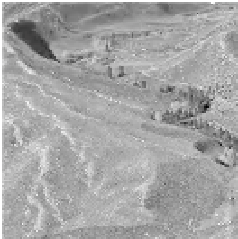Geology Reference
In-Depth Information
2
Geomorphic markers
In order to measure the amount of deformation
that has occurred due to tectonic processes, it
is typically necessary to have an identifiable
feature that has been displaced. Unique rock
types or structures that formerly extended across
a fault in an unbroken pattern provide a datum
or “piercing point” from which the magnitude of
subsequent displacements can be determined.
In order to calculate the displacement reliably, the
pre-deformational geometry of a presently offset
feature has to be reconstructed accurately. The
better that geometry is known, the more reliably
the offset can be calculated.
In tectonic geomorphology, we are often
concerned with offset geomorphic
markers
, by
which we mean identifiable geomorphic features
or surfaces that provide a reference frame
against which to gauge differential or absolute
deformation. The best geomorphic markers
are readily recognizable landforms, surfaces, or
linear trends that display these three characteris-
tics: (i) a known initial, undeformed geometry;
(ii) a known age; and (iii) high preservation
potential with respect to the time scale of the
tectonic process being studied. Oftentimes, only
some of these characteristics may have been
determined for a displaced marker. Because of
the usefulness of geomorphic markers, consid-
erable effort and care are warranted in defining
their geometry and age. In this chapter, we
examine the pristine shape of many useful
markers, such as river or coastal terraces, and
discuss the conditions under which they are
likely to form.
The geometry of a pristine geomorphic feature
is a crucial attribute of a marker, because the
deformation of the surface of such a feature
records the tectonic signal. Modifications of
an original undisturbed feature by subsequent
erosion or deposition, however, may make it
difficult to define the original geometry of a
presently offset geomorphic surface. In such
cases, the probable geometry of the feature can
sometimes be predicted through comparison
with undeformed modern analogs. For example,
river terraces are frequently used as geomorphic
markers to document fault offsets or folds
(Molnar
et al.
, 1994; Rockwell
et al.
, 1984;
Thompson
et al.
, 2002). Unfortunately, the
preservation of river terraces becomes inc-
reasingly fragmentary as they get older and
more extensively dissected. In such a situation,
the profile of the modern river or of young,
nearly undissected terraces along the same or
analogous reaches of the river provides models
for the smooth downstream changes in the
longitudinal profiles of rivers. Such profiles can
then be used to predict the geometry of older
terraces prior to deformation.
The age of a geomorphic marker is a critical
ingredient when calculating rates of deformation.
Most markers form in response to either climatic
or tectonic controls. Some markers form due to
autocyclic processes, such as landsliding, which































